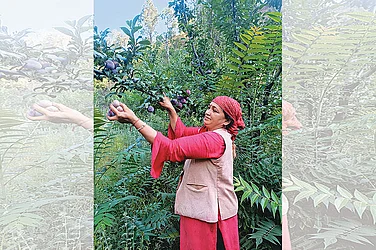It라이브 바카라 March. People in Shimla are waking up to a pleasant breeze, unlike the icy cold winds of the past few months. The winter chill is gradually fading and clear blue skies are visible again. Routine morning walkers are ditching their warm thermals and quilts and are stepping out of the comforts of their homes.
The forest road—lined with tall deodar trees on either side—is their favourite stretch. The foggy mornings offer breathtaking views. The evening leisure strollers, on the other hand, are charmed by the magical sunsets that are ameliorating the beauty of the majestic Himalayan range.
Something else has changed. The landscape, these days, looks like a canvas—there are splashes of pink, red, maple and white. It라이브 바카라 the season of rhododendrons. The blooming of the buransh flowers in the hill town marks the early arrival of spring—April is when the spring season usually begins in Shimla.

Noted author E.J. Buck in his book Simla, Past and Present has devoted one full chapter to the trees of Shimla. He introduces rhododendrons as “the glory of the Himalayan spring”. He writes in the book: “The flowers (bloom) of rhododendron greet our annual arrival with a blaze of rich crimson and scarlet. Flowers are commonly crimson-scarlet, occasionally white, pink or rose or marked with purple or yellowish spots. It is certainly the fact that the colouring depends somewhat on aspect and elevation.”
Many nature lovers and poets have celebrated rhododendrons in folksongs, literary writings, love-stories and poems. “Rhododendrons bloom in clusters and stand out for their fascinating look. Though the plant is found in other parts of Himachal Pradesh, Uttarakhand and Nepal, but its presence in Shimla enables us to boast about our rich biodiversity and diverse flora and fauna,” says Uma Thakur, a writer and a poet.
Though the blooming of rhododendrons has made the landscape prettier, some people, especially environmentalists, are a bit worried. The bloom has happened almost three weeks early for the second consecutive year. They are terming the early bloom as disappointing and a symbol of ‘climate disruption’ in the Himalayan region. “The changing pattern of the flowering of rhododendrons requires deeper study. This is not a good sign,” says Thakur.
Plant scientists in Shimla are attributing the early bloom to weather advances, warming of days and the gradual decline in snowfall patterns.
“A rise in temperature implies low chilling in plants in the mountains where snow regulates their growth. Rhododendrons fall under this category. Maybe the quality of flowers is different in terms of juice or phenolic contents but it is immaterial as it blooms in wild habitats. This year, we have had exceptionally poor snowfall. Therefore, these changes are obvious,” informs Vijay Singh Thakur, a scientist and the former vice-chancellor Dr Y S Parmar University of Horticulture and Forestry, Nauni, Solan.
Suresh Attri, principal scientist in the Department of Environment and Climate Change, admits that the early blooming of rhododendrons is certainly a matter of concern among those associated with the environment and forestry fields.
“Besides the changing flowering pattern, scientists are also concerned about the shifting of the baseline of rhododendrons. A few popular varieties have become rare and variation in rainfall pattern and the rise in temperature is shifting the altitudes at which rhododendrons bloom,” says Attri.
Climatic changes affecting the bloom of rhododendrons is concerning as they also have medicinal value. They have anti-oxidant, anti-inflammatory and anti-bacterial properties. Some private fruit wine manufacturers in Himachal Pradesh have also harvested these flowers as they are used in making the finest wines and cider. The flowers also attract birds and bees seeking nectar.
The plant is said to be a powerful air purifier and maintains a cleaner and healthier environment. It absorbs pollutants, particularly nitrogen dioxide, from the air. “It also prevents soil erosion and retains moisture,” says Attri.
India라이브 바카라 first rhododendron garden has come up in Pithoragarh district in Uttarakhand that houses more than 30 species of the flower; five are exclusively found in Uttarakhand.
The Nagaland government has declared Rhododendron as a state flower and started a project to conserve and save some of the species facing a threat due to deforestation, habitat loss and climate change.
Reports say till now only four species of Rhododendron have been found in Himachal Pradesh. These include arboretum (the tree form), campanulatum (tall shrubby form), anthopogon (small shrubby form) and lepidotum (small shrubby form).














